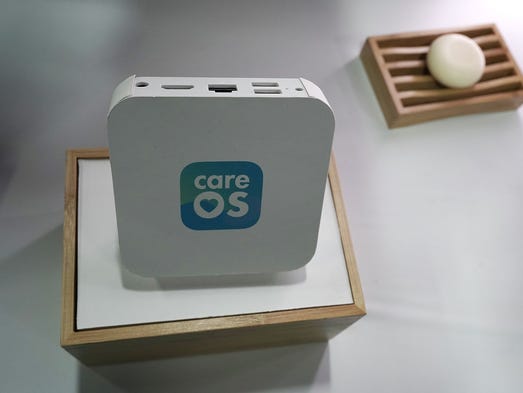Jefferson Graham runs down the winners and losers of CES 2018. USA TODAY
LAS VEGAS—The least popular gadget in the news last week—and the latest shopper-beware lesson from the tech industry—may have been a single device in a corner of a Kodak exhibit at the CES convention here.
That rectangular gadget was a high-powered computer made to “mine” Bitcoin by performing the increasingly intense calculations that generate more of the digital currency.
By itself, Bitcoin has already earned a bit of a toxic reputation for such traits as its extreme instability, the growing number of scams targeting the Bitcoin-curious, and its status as the currency of ransomware. But wait, there’s more.
The former photography giant had put this machine on display to attract renters, not buyers. A Kodak licensee called Spotlite USA would have you pay $3,400 for two years’ use of one of these contraptions, housed at a facility near Kodak’s Rochester, N.Y. offices. In return, Spotlite would keep half of all the Bitcoins it generated over that time.
More: Kodak shares have more than tripled since announcing new cryptocurrency 'KodakCoin'
More: Kodak creating KodakCoin, develops its own cryptocurrency system
In a conversation on the show floor Thursday, Spotlite CEO Halston Mikail put that as a good deal that’s already attracting customers.
"Your $3,400 becomes $9,000," he said, adding that Spotlite benefits from low electricity costs of just 4 cents per kilowatt from a local coal-fired plant.
(Your own home may have much cleaner power, but you wouldn’t want to keep a Bitcoin miner there anyway. Beyond its voracious appetite for electricity, its cooling fans make a racket that Mikail compared to having a hair dryer on high.)
The dubious math behind Spotlite’s pitch drew an extra level of scorn.
The basic problem, as BuzzFeed’s Ryan Mac explained in a post headlined “This Is Why Experts Are Calling Kodak's New Bitcoin Scheme A Scam,” is that it gets progressively more difficult to mine more bitcoin. So unless Bitcoin’s value increases far above its current level—the classic expectation behind a doomed market bubble—a renter of Kodak’s miner can’t possibly make the promised returns.
In that aspect, this Bitcoin play looks uniquely bad among gadget debuts for not just surfing on an overhyped trend but for banking on consumer innumeracy.
But in too many other ways, it fits quite well with a longstanding tradition of tech excess disconnected from real-world utility. Think of 4K screens on phones and 8K displays in TVs that pack in more resolution than human retinas can perceive at normal viewing distances. Or contemplate Apple and Google removing headphone jacks on smartphones because making a mobile device infinitesimally smaller outranks keeping a perfectly functional, universally supported connector.
More: Here's what we wanted to see from CES, but didn't
More: I just bought a 4K TV. Don't tell me 8K is coming!
More: These are the best phones that still have a headphone jack
In all these cases, the problem isn’t just tech companies selling something most people don’t need, but also the diversion of effort and expertise that could have gone into something that people actually need. For example, extremely fast computation is a lot more useful in a self-driving car that can make the roads more efficient and safer.
But as long as the gadget business stays this wide-open and this potentially lucrative, you’re going to keep seeing dubious propositions like Spotlite’s bitcoin-mining deal. When you see them, just remember to ask one simple question: What’s the actual problem you’re trying to solve here?
Posted!
A link has been posted to your Facebook feed.




































































































Like this topic? You may also like these photo galleries:
![Casio's G's Eye is a wearable action on display at]() 1 of 100
1 of 100![Tomer Yehezkel takes part in a virtual reality demonstration]() 2 of 100
2 of 100![People crowd around a display of service robots at]() 3 of 100
3 of 100![People crowd around a display of service robots at]() 4 of 100
4 of 100![People take snapshots before entering extensive Samsung]() 5 of 100
5 of 100![People walk through LG's tunnel of OLED TVs at the]() 6 of 100
6 of 100![The TLC display at the 2018 Consumer Electronics Show]() 7 of 100
7 of 100![People crowd around the Huawei display to look over]() 8 of 100
8 of 100![The Huawei Mate10 Pro cellphone on displayed.]() 9 of 100
9 of 100![Weibin Chen, left, and Zhuo Li look over the Huawei]() 10 of 100
10 of 100![Attendees watch a 3D version of the classic movie "It's]() 11 of 100
11 of 100![Stream TV, based in Philadelphia, showed off their]() 12 of 100
12 of 100![The Tainerz, a rap and dance group from New Orleans,]() 13 of 100
13 of 100![Cara Tass takes a selfie on an adjustable bed at the]() 14 of 100
14 of 100![The R-Pur is an anti-pollution mask. The company says]() 15 of 100
15 of 100![ProGlove is a smart glove that features sensors and]() 16 of 100
16 of 100![The Mito underwater drone is demonstrated at the Navatics]() 17 of 100
17 of 100![Morgan Sanserino, of TotoUSA, demonstrates the company's]() 18 of 100
18 of 100![A robotic prosthetic hand is controlled by CES attendee]() 19 of 100
19 of 100![Orbit is one of several companies showing off bluetooth]() 20 of 100
20 of 100![Autel Robotics showed off their Evo Drone.]() 21 of 100
21 of 100![Robomart is a driverless, electric, mobile market that]() 22 of 100
22 of 100![Attendees get a chance to play the Golfzon Vision Compact]() 23 of 100
23 of 100![A Jimu Robot dances at the Ubtech. The Jimu Robot]() 24 of 100
24 of 100![Orbit is one of several companies showing off bluetooth]() 25 of 100
25 of 100![A new app for the Litter-Robot Open Air, an automatic]() 26 of 100
26 of 100![Juliana Fernandez tries DJI's immersive goggles that]() 27 of 100
27 of 100![James Hill looks over Kodak's Super 8 movie camera.]() 28 of 100
28 of 10029 of 100
30 of 100
31 of 100
32 of 100
33 of 100
34 of 100
35 of 100
36 of 100
37 of 100
38 of 100
39 of 100
40 of 100
41 of 100
42 of 100
43 of 100
![The controller for LG robot lawn mower draws a crowd.]() 44 of 100
44 of 10045 of 100
46 of 100
47 of 100
![This is the newest generation of the Aibo robot, which]() 48 of 100
48 of 10049 of 100
50 of 100
51 of 100
52 of 100
53 of 100
54 of 100
![Drone pilot Colby Curtola flies a small consumer drone]() 55 of 100
55 of 100![Drone pilot Travis Ames demonstrates an aircraft during]() 56 of 100
56 of 100![A Volocopter, the first Intel-powered autonomous air]() 57 of 100
57 of 100![These are the Sony WF-SP700N noise-canceling earphones.]() 58 of 100
58 of 100![This is Sony's Aibo robot dog.]() 59 of 100
59 of 100![People look through Sony PlayStation VR headsets.]() 60 of 100
60 of 100![These are Vuzix augmented reality smart glasses.]() 61 of 100
61 of 100![Eric Chen, of Bellus 3D, holds up a lifelike 3D rendering]() 62 of 100
62 of 100![A woman takes pictures of the R-Pur face mask.]() 63 of 100
63 of 100![This is a SABINETEK SMIC recording condenser microphone.]() 64 of 100
64 of 100![Saxophonist Eddie Rich plays at the Dassault booth.]() 65 of 100
65 of 100![A RAPAEL Smart Board, which assists rehabilitation]() 66 of 100
66 of 100![These are E-vone smart shoes.]() 67 of 100
67 of 100![ZeTime hybrid smart watches.]() 68 of 100
68 of 100![The Caveasy One connected wine rack.]() 69 of 100
69 of 100![Gabriel Pleszowski gets his skin analyzed using Neutrogena's]() 70 of 100
70 of 100![The Electron Wheel converts a traditional bicycle into]() 71 of 100
71 of 100![Victoria Roa-Stevenson shows myBrain Technologies's]() 72 of 100
72 of 100![An attendee creates a postcard with his selfie using]() 73 of 100
73 of 100![Mirian da Silva demonstrates the HiMirror Plus smart]() 74 of 100
74 of 100![The Benjilock, a rechargeable lock that uses fingerprint]() 75 of 100
75 of 100![The HiMirror Mini, an internet-connected smart mirror]() 76 of 100
76 of 100![Byton CEO and Co-Founder Dr. Carston Breitfeld talks]() 77 of 100
77 of 100![An exhibitor demonstrates the Virtual Reality headset]() 78 of 100
78 of 100![Some of GDU Technology's drones.]() 79 of 100
79 of 100![Raboo smart chargers.]() 80 of 100
80 of 100![The LG PuriCare TM 360 air purifier with SmartThinQ.]() 81 of 100
81 of 100![LooxidVR, the first mobile VR headset to provide an]() 82 of 100
82 of 100![CareOS, the first smart health and beauty hub for the]() 83 of 100
83 of 100![Shane Chen rides his latest invention a self-balancing]() 84 of 100
84 of 100!["Buddy" a companion robot from Blue Frog Robotics.]() 85 of 100
85 of 100![Dingua Zhong and Bastiaan Vroegop (rear) try the Aurasens]() 86 of 100
86 of 100![Austin Yu, of Neofect, shows off the company's Rafael]() 87 of 100
87 of 100![A man walks past a sign for the 2018 Consumer Electronics]() 88 of 100
88 of 100![The registration tent can be seen at the Las Vegas]() 89 of 100
89 of 100![Workers prepare a sign at the Panasonic booth at the]() 90 of 100
90 of 100![Workers prepare exhibits outside the Las Vegas Convention]() 91 of 100
91 of 100![The 2018 Consumer Electronics Show is expected to as]() 92 of 100
92 of 100![The 2018 Consumer Electronics Show is expected to as]() 93 of 100
93 of 100![The 2018 Consumer Electronics Show is expected to as]() 94 of 100
94 of 100![The 2018 Consumer Electronics Show is expected to as]() 95 of 100
95 of 100![The 2018 Consumer Electronics Show is expected to as]() 96 of 100
96 of 100![The 2018 Consumer Electronics Show is expected to as]() 97 of 100
97 of 100![The 2018 Consumer Electronics Show is expected to as]() 98 of 100
98 of 100![The 2018 Consumer Electronics Show is expected to as]() 99 of 100
99 of 100![The 2018 Consumer Electronics Show is expected to as]() 100 of 100
100 of 100
Rob Pegoraro is a tech writer based out of Washington, D.C. To submit a tech question, e-mail Rob at rob@robpegoraro.com. Follow him on Twitter at twitter.com/robpegoraro.






































































































Join the Nation's Conversation
To find out more about Facebook commenting please read the Conversation Guidelines and FAQs